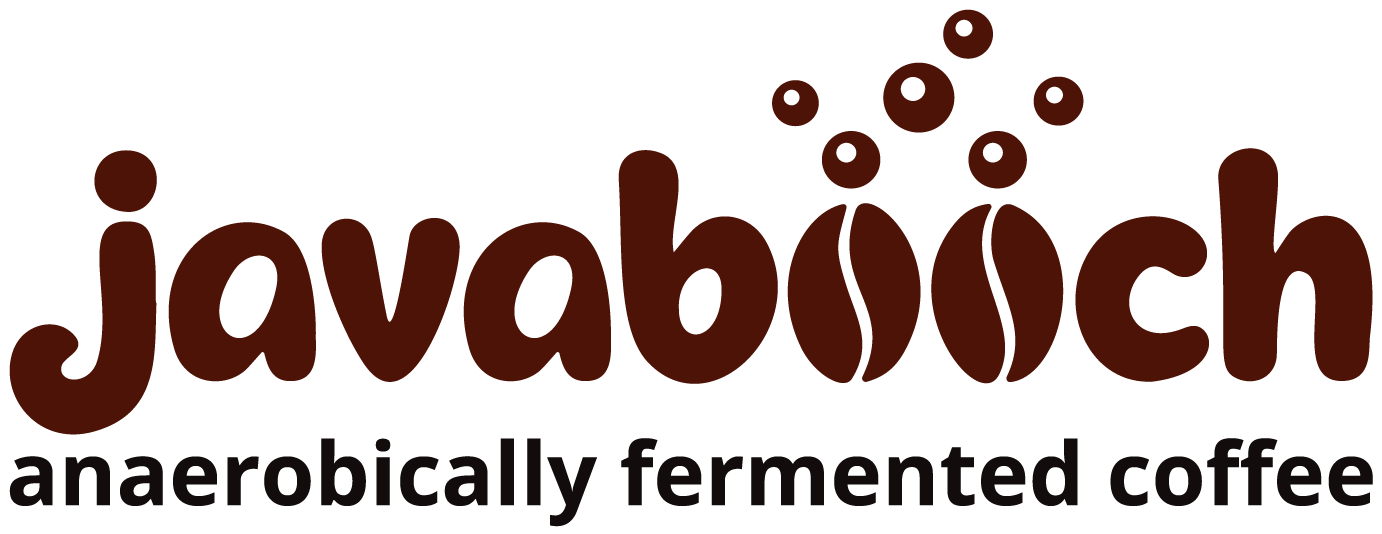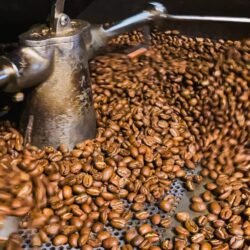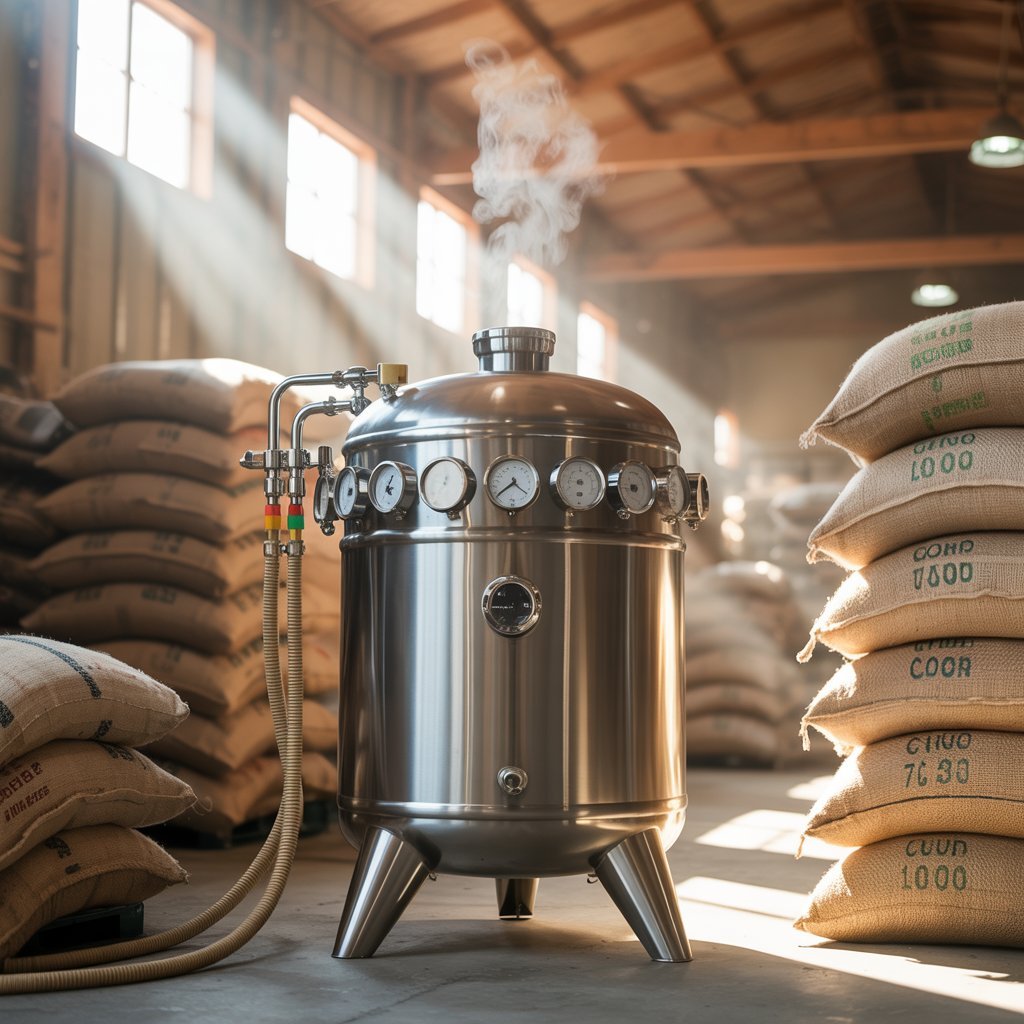Walk into some modern coffee mills today and you might think you’ve stepped into a small winery. You see clean tanks with little airlocks gently bubbling, people checking temperature and smell, and lots of careful note-taking. What’s happening is anaerobic coffee fermentation—a method that takes ideas long used in wine (keep oxygen out, guide the natural microbes, watch the numbers) and applies them to coffee cherries to unlock new flavors. Instead of just spreading coffee out or soaking it in open tanks, producers now seal ripened cherries (or the sticky beans after removing the skin) inside a closed container so the natural sugars ferment slowly without outside air.
Why bring wine ideas into coffee? Winemakers learned that controlling the environment during fermentation—temperature, time, and cleanliness—creates more consistent and expressive flavors. Coffee growers saw they could do the same: rather than letting nature run wild, they gently steer the process. By limiting oxygen, they slow things down. This calmer, slower fermentation lets friendly yeasts and bacteria turn sugars into pleasant flavor compounds—fruity aromas, gentle sweetness, and a creamy feel—before any harsh, vinegary tastes appear.
The basic flow is easy to picture. First, pick only fully ripe, healthy, brightly colored cherries. Anything under-ripe or damaged gets removed so it doesn’t drag the batch down. The good cherries are rinsed and sorted, then placed into a clean, food-safe tank. The lid is closed, and a small one-way valve lets built-up gas escape while blocking fresh air. Inside, the fruit begins to gently “work”—not a wild boil, just a quiet, slow activity. Farmers periodically check smell (is it sweet and fruity or sharp and sour?), feel (is the fruit softening too quickly?), and sometimes simple readings (like how sugary the juice still is or whether the natural acidity has dropped). When the fruit reaches a sweet, winey, fruit-punch stage—before turning sharp—they stop the fermentation, remove the beans (still with sticky mucilage or after a light rinse, depending on the style), and dry them slowly on raised beds or patios until the moisture level is safe for storage. After drying, the beans rest a few weeks so the flavors even out, then they’re hulled, sorted, and shipped.
What does this do for flavor in the cup? Compared with a classic washed coffee (clean, bright, citrusy) or a natural coffee (jammy, heavier, sometimes a little wild), a well-done anaerobic batch can taste like a blend of both worlds with extra layers. People often describe ripe strawberry, tropical fruit, floral honey, gentle spice, or a yogurt-like smooth finish. The body (the feel on your tongue) can become silkier, and the sweetness can stretch from the first sip to the aftertaste. It is not magic—bad cherries still taste bad, and sloppy handling still shows. But good raw material plus careful sealed fermentation can nudge hidden notes to the surface.
There are real advantages for growers. A standout flavor profile can earn a higher price, which helps offset the added work of cleaning tanks and tracking batches. It can also build a farm’s reputation: roasters remember memorable cups. For roasters, these coffees offer new stories to share with customers—people love hearing that their coffee was “handled like a fine wine.” And for everyday coffee drinkers, it’s simply a chance to discover tastes they may never have imagined belonged to coffee at all.
Of course, it isn’t all upside. Leave the cherries sealed too long and the pleasant fruity aroma can tip into sharp, sour vinegar or funky notes that distract rather than delight. Poor hygiene (dirty tanks, leftover pulp) can introduce moldy or muddy flavors. Letting air leak i…
[17:40, 19/07/2025] Martin USA: Wine-Making Precision Meets Coffee
Walk into some modern coffee mills today, and you might think you’ve stepped into a small winery. You see clean tanks with little airlocks gently bubbling, people checking temperature and smell, and lots of careful note-taking. What’s happening is anaerobic coffee fermentation—a method that takes ideas long used in wine (keep oxygen out, guide the natural microbes, watch the numbers) and applies them to coffee cherries to unlock new flavors. Instead of just spreading coffee out or soaking it in open tanks, producers now seal ripened cherries (or the sticky beans after removing the skin) inside a closed container so the natural sugars ferment slowly without outside air.
Why bring wine ideas into coffee? Winemakers learned that controlling the environment during fermentation—temperature, time, and cleanliness—creates more consistent and expressive flavors. Coffee growers saw they could do the same: rather than letting nature run wild, they gently steer the process. By limiting oxygen, they slow things down. This calmer, slower fermentation lets friendly yeasts and bacteria turn sugars into pleasant flavor compounds—fruity aromas, gentle sweetness, and a creamy feel—before any harsh, vinegary tastes appear.
The basic flow is easy to picture. First, pick only fully ripe, healthy, brightly colored cherries. Anything under-ripe or damaged gets removed, so it doesn’t drag the batch down. The good cherries are rinsed and sorted, then placed into a clean, food-safe tank. The lid is closed, and a small one-way valve lets built-up gas escape while blocking fresh air. Inside, the fruit begins to gently “work”—not a wild boil, just a quiet, slow activity. Farmers periodically check smell (is it sweet and fruity or sharp and sour?), feel (is the fruit softening too quickly?), and sometimes simple readings (like how sugary the juice still is or whether the natural acidity has dropped). When the fruit reaches a sweet, winey, fruit-punch stage—before turning sharp—they stop the fermentation, remove the beans (still with sticky mucilage or after a light rinse, depending on the style), and dry them slowly on raised beds or patios until the moisture level is safe for storage. After drying, the beans are allowed yo rest for a few weeks, so the flavors even out, then they’re hulled, sorted, and shipped.
What does this do for flavor in the cup? Compared with a classic washed coffee (clean, bright, citrusy) or a natural coffee (jammy, heavier, sometimes a little wild), a well-done anaerobic batch can taste like a blend of both worlds with extra layers. People often describe ripe strawberry, tropical fruit, floral honey, gentle spice, or a yogurt-like smooth finish. The body (the feel on your tongue) can become silkier, and the sweetness can stretch from the first sip to the aftertaste. It is not magic—bad cherries still taste bad, and sloppy handling still shows. But good raw material plus careful sealed fermentation can nudge hidden notes to the surface.
There are real advantages for growers. A standout flavor profile can earn a higher price, which helps offset the added work of cleaning tanks and tracking batches. It can also build a farm’s reputation: roasters remember memorable cups. For roasters, these coffees offer new stories to share with customers—people love hearing that their coffee was “handled like a fine wine.” And for everyday coffee drinkers, it’s simply a chance to discover tastes they may never have imagined belonged to coffee at all.
Of course, it isn’t all upside. Leave the cherries sealed too long, and the pleasant fruity aroma can tip into sharp, sour vinegar or funky notes that distract rather than delight. Poor hygiene (dirty tanks, leftover pulp) can introduce moldy or muddy flavors. Letting air leak in can wake up microbes that produce harsh, biting acidity. So success comes down to cleanliness (rinse and sanitize tanks between batches), careful watching (stop while things still smell bright and sweet), and patience (slow steady drying afterward—rushing the drying can flatten the very flavors you worked to create).
If you’re a home roaster or curious barista, treat an anaerobic lot gently. Lighter to medium roasts often let the fruit shine without burning off the delicate aromatics. When brewing, you do not need special gear—just use fresh grinding, clean water, and taste your way to a recipe. If a cup seems too intensely fruity or perfumed, try a slightly lower water temperature or a touch coarser grind to calm it down. Describe it to customers in familiar terms: “It was fermented in a sealed tank—kind of like a small batch wine—so you get these bright strawberry and tropical notes.” That bridges the idea without overwhelming them with lab talk.
In the bigger picture, anaerobic fermentation is part of a broader shift in coffee toward more intention and less guesswork. Just as winemakers moved from rustic guess-and-check to clean, measured methods, coffee producers are learning they can shape flavor more reliably. Not every coffee needs to be anaerobic; classic washed and natural styles still have their place and charm. But this approach adds a fresh tool—one that can make a farm’s work stand out, delight curious drinkers, and help justify better pay for higher effort.
So the next time you sip a cup that tastes like a bowl of ripe berries with a creamy finish, remember: those flavors are not artificial; they were gently coaxed out by time, temperature, and the quiet teamwork of natural microbes in a little closed tank—an echo of the wine cellar brought into the coffee world. That meeting point—wine-making precision and coffee passion—is opening a new chapter in what we can expect from the humble bean. Enjoy the discovery.




